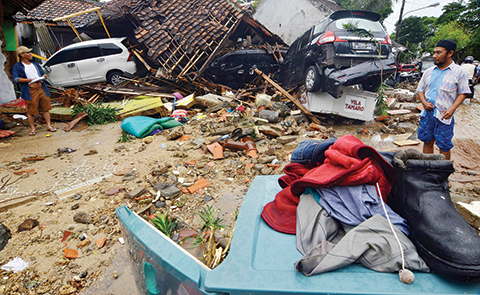

CARITA,Indonesia: A volcano-triggered tsunami has left at least 222 people dead andhundreds more injured after slamming without warning into beaches aroundIndonesia's Sunda Strait, officials said yesterday, voicing fears that the tollwould rise further. Hundreds of buildings were destroyed by the wave, which hitthe coast of southern Sumatra and the western tip of Java about 9:30 pm (1430GMT) on Saturday after a volcano known as the "child" of Krakatoaerupted, national disaster agency spokesman Sutopo Purwo Nugroho said.
Dramatic videoposted on social media showed a wall of water suddenly crashing into a concertby pop group "Seventeen" - hurling band members off the stage andthen flooding into the audience. In a tearful Instagram post, frontman RiefianFajarsyah said the band's bassist and road manager had been killed and his wifewas missing. Search and rescue teams were scouring rubble for survivors, with222 people confirmed dead, 843 people injured and 28 missing, Nugroho said.
HH the Amir ofKuwait Sheikh Sabah Al-Ahmad Al-Jaber Al-Sabah sent a cable of condolences toIndonesian President Joko Widodo yesterday. In the cable, he expressed sinceregrief towards the victims of the tsunami. HH the Amir wished the injured quickrecuperation and hoped the nation will be able to cope with the consequences ofthe natural catastrophe. HH the Crown Prince Sheikh Nawaf Al-Ahmad Al-JaberAl-Sabah and HH the Prime Minister Sheikh Jaber Al-Mubarak Al-Hamad Al-Sabahsent similar cables to the Indonesian president.
Tsunamistriggered by volcanic eruptions are relatively rare, caused by the suddendisplacement of water or "slope failure", according to theInternational Tsunami Information Centre. Unlike those caused by earthquakes,which trigger alert systems, they give authorities very little time to warnresidents of the impending threat. The destructive wave left a trail ofuprooted trees and debris strewn across beaches. A tangled mess of corrugatedsteel roofing, timber and rubble was dragged inland at Carita beach, a popularspot for day-trippers on the west coast of Java.
PhotographerOystein Andersen described how he was caught up in the disaster while on thebeach taking photos of Anak Krakatoa. "I suddenly saw a big wave," hewrote on his Facebook page. "I had to run, as the wave passed the beachand landed 15-20m inland. (The) next wave entered the hotel area where I wasstaying and downed cars on the road behind it." The InternationalFederation of Red Cross and Red Crescent Societies said the "powerfulwaves" reached a height of 30-90 cm.
Asep Perangkatsaid he was with his family when the wave surged through Carita, carving aswathe of destruction, dragging cars and shipping containers. "Buildingson the edge of the beach were destroyed. Trees and electric poles fell to theground," he told AFP. In Lampung province, on the other side of thestrait, Lutfi Al Rasyid fled the beach in Kalianda city, fearing for his life."I could not start my motorbike so I left it and I ran... I just prayedand ran as far as I could," the 23-year-old told AFP.
Kathy Muellerfrom the International Federation of Red Cross and Red Crescent Societies saidthe toll was likely to rise as the conditions on the ground became clearer."The situation, and the death toll, will remain fluid over the next daysand even weeks," she told AFP. Aid workers were helping to evacuate theinjured and bring in clean water, tarpaulins and provide shelter, she added, sayingthe group was preparing for the possibility of diseases breaking out in thetsunami zone.
Anak Krakatoa,which forms a small island in the Sunda Strait between Java and Sumatra,emerged around 1928 in the crater left by Krakatoa, which erupted in 1883killing at least 36,000 people. "The cause of the undersea landslide wasdue to volcanic activity of Anak Krakatoa, which coincided with a high tide dueto the full moon," Nugroho told reporters in Yogyakarta.
Professor DavidRothery from The Open University said that the proximity of the volcano to thecoast gave authorities very little time to act. "Tsunami warning buoys arepositioned to warn of tsunamis originated by earthquakes at underwater tectonicplate boundaries. Even if there had been such a buoy right next to AnakKrakatau, this is so close to the affected shorelines that warning time wouldhave been minimal given the high speeds at which tsunami waves travel," hesaid.
Indonesianauthorities initially said the wave was not a tsunami, but instead a tidalsurge and urged the public not to panic. Nugroho later apologized, sayingbecause there was no earthquake it had been difficult to ascertain the cause ofthe incident early on. "If there is an initial error we're sorry," hewrote on Twitter. The wave swamped parts of the coast around the Sunda Strait,leaving at least 164 people dead in worst-affected Pandeglang district onJava's western tip. Large numbers of casualties were recorded at two hotels inthe area, Nugroho said, without elaborating.
Eleven peopledied further north in Serang, while 48 were killed in South Lampung, on Sumatraisland. Heavy equipment was being transported to badly hit areas to help searchfor victims and evacuation posts and public kitchens were being set up forevacuees, he added. According to Indonesia's geological agency, Anak Krakatoahad been showing signs of heightened activity for days, spewing plumes of ashthousands of meters into the air.
Indonesia is oneof the most disaster-prone nations on Earth due to its position straddling theso-called Pacific "Ring of Fire", where tectonic plates collide. Mostrecently in the city of Palu on Sulawesi island a quake and tsunami inSeptember killed thousands of people. On Dec 26, 2004 a tsunami triggered by amagnitude 9.3 undersea earthquake off the coast of Sumatra in western Indonesiakilled 220,000 people in countries around the Indian Ocean, including 168,000in Indonesia. - Agencies

